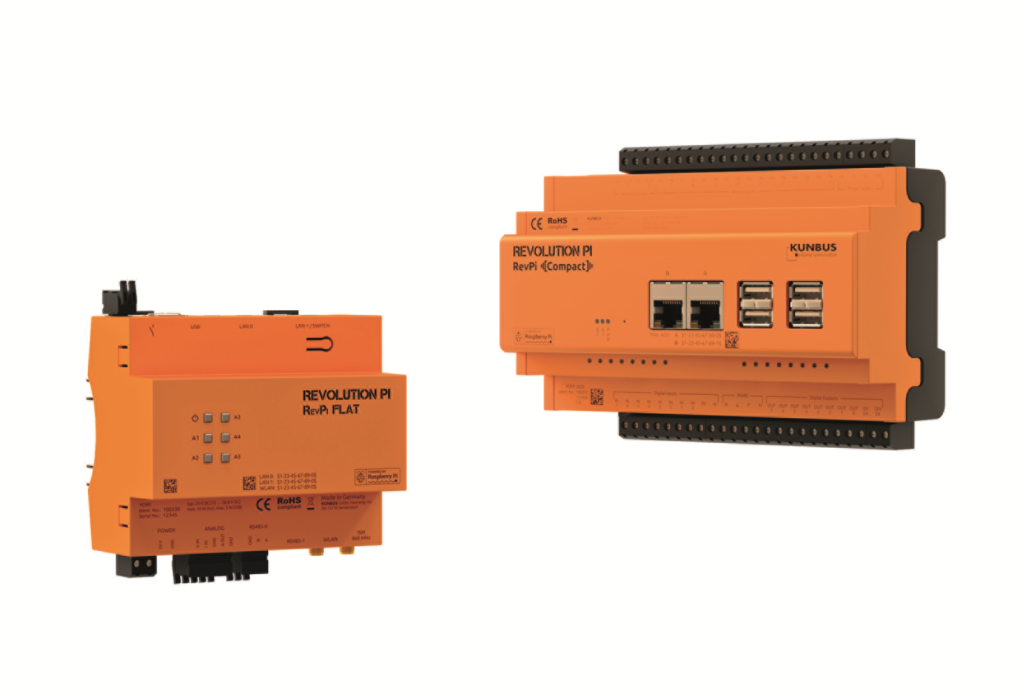
Nicolai Buchwitz Product Owner for the Revolution Pi product family at KUNBUS
Nicolai Buchwitz changed sides in October 2021 and has joined KUNBUS as Product Owner for the Revolution Pi product family. As a long-time user, he is very familiar with the extensive possibilities of the RevPi. In the past, he realised many industrial projects with the Revolution Pi, such as the European availability monitoring for H2 filling stations.
1. How is KUNBUS involved in the IIoT industry?
With the “Revolution Pi”, we have created modules for automation technology based on the Raspberry Pi. This modular and open-source hardware platform includes flexible, industrial-grade and cost-effective devices for implementing a wide variety of automation and IIoT projects. We support our customers in networking their machines, systems, and plants. With our devices, it is possible to receive, store, process and send data and sustainably increase productivity and profitability.
2. What do you think are the key factors in driving this industry forward?
In the context of Industry 4.0 and IIoT, the demands on the control level are changing dramatically. On the one hand, the demand for decentralised controllers is rising strongly, and on the other hand, completely different applications are gradually being integrated into higher-level networks. Decentralised solutions are becoming more and more important and are greatly increasing the demand for inexpensive, scalable, and industrial-grade controllers as well as intelligent nodes, for example to connect devices to a cloud. Free connectivity is a basic requirement for decentralised solutions. Closed systems do not offer this accessibility and prevent fast and cost-effective solutions for existing systems or controllers. With the development of the Revolution Pi, we paid tribute to the demand for open source. Both the hardware of the base and I/O modules and the software of the Revolution Pi are open source.
3. What are the concrete advantages for users of the Revolution Pi?
The RevPi can be used very flexible in many different applications. On the other hand, we supply many expansion modules, such as analog and digital I/O modules as well as fieldbus gateways. The user also benefits, as already emphasised, from the openness of the system. He can use for example the supplied operating system (OS) or develop and install his own system – nearly any OS can be installed that runs on an ARM or Raspberry Pi basis. The supplied OS is based on that of the Raspberry Pi Foundation. We also support customers in running their own applications on the RevPi. So, users who have done rapid prototyping on a classic Raspberry Pi can port their projects very easy to the RevPi and thus into industry.
Even the circuit diagrams of our modules are freely accessible on our homepage. We also try to integrate important patches already when compiling the operating system. Furthermore, there is our community forum, where both our developers and our support read along and help customers to develop their own solutions. For high-volume customers or OEMs, we offer to create a customised software image during production and to adapt the exterior of the device to their own corporate identity. With CODESYS as software, our RevPi models can even be used as PLCs.
4. What news can we expect in 2022?
The Revolution Pi 4, based on the Raspberry Pi Foundation’s CM 4, is expected to be launched at the end of 2022. The most important new features are the more powerful CPU and the larger RAM. This is especially interesting for edge computing applications. The RevPi 4 will be available in different versions with up to 8 GB RAM memory. We will also offer the possibility of native WLAN, as well as a Gigabit Ethernet (GbE) interface.
5. Is there a specific target group that you address with the RevPi?
Our target group ranges from classic automation companies that want to implement a control system with CODESYS to application developers who, for example, are building a hydrogen tank or electric charging columns. In addition, there are more and more classic IT companies that need to connect their software with physical systems.
6. What do you think are the most challenging aspects to working in this industry at the moment?
In the area of hardware development, allocation causes challenges for us. For new tests and designs, we are therefore always dependent on current delivery times. Even if we commit to a chip during development, we cannot always guarantee that it will be available at the time of production.
In contrast, software development is rarely limited by the market. Here, the recruitment situation is causing more and more problems. Since the beginning of the pandemic, the job market has shifted a bit, as more and more companies offer the option of home offices. This makes it more difficult for us to grow because we are in much greater competition with large companies now.
7. How do you think security concerns have been addressed?
The comprehensive safety concept is particularly important for KUNBUS, because the RevPi should be as flexible as possible and be able to be used for a variety of applications, without us having to know the respective areas of application of our customers in detail. For example, our customers can develop their own image for the applications. What their software does exactly, we can only guess, but we don’t know exactly. In terms of software security, we highly benefit from the fact that our image is based on the popular raspberry pi OS, which will ensure that critical software updates are provided as fast as possible.
8. Investing in IIoT solutions can be costly if not done right, what level of support do you offer your customers in adopting your solutions?
If you choose Revolution Pi as your standard hardware we can customize and produce customized modules. Our customers can concentrate on their main business and core competence and don`t get distracted by time consuming hardware development. Their solution gets to the market faster without investing large sums in hardware development. As brand labeling and customization is always a complex issue, the details must be clarified individually with our sales team. A team of interdisciplinary experts make sure that our customers are provided with best possible support. Besides our support team we are proud to have our revolution pi community forums, where customers and IoT experts share their experiences and knowledge.
9. What do you think will be the main focus in IIoT over the next couple of years?
In our view, the open-source trend continues to spread. For example, classic software companies are looking for platforms to move their applications away from cloud architectures to the edge and closer to the customer. In addition, Ethernet-based fieldbus communication continues to spread, for example OPC UA or cloud connectivity. Here, for example, we are working successfully with Cloudrail, which provides cloud connectors for various platforms such as Google or AWS based on our hardware.
10. The IoT industry has many manufacturers all working toward various standards or proprietary specifications, this prevents challenges when communicating between one-another. How open would you say your solutions are in the industry?
We have consequently continued the basic idea of the Raspberry Pi. Therefore, both the hardware of the base and I/O modules as well as the software of the Revolution Pi are open source. In the meantime, the success of Revolution Pi shows that the risk of launching an open-source product on the automation market was worth it. Not only the permanently increasing demand for Revolution Pi, but also the fact that the big players in the automation industry are becoming more interested in open source, strengthens our conviction that we made the right decision in the past.
11. What is unique about Revolution Pi?
We see the unique feature of the Revolution Pi in the combination of the following aspects: It is based on the Raspberry Pi and its community with all its application solutions, customers can also use their own operating systems, as an open-source device its circuit diagram concept is published on Github and it is completely independent of manufacturers and their specifications. In other words, the exact opposite of being proprietary.
12. How do you support real-time data driven productivity?
The Revolution Pi is suitable for almost all applications except motion control with extremely short cycle times. The flexibility of being an opensource device allows the customer to run the software of their choice.
13. Keyword sustainability: How far do you pay attention to sustainable components and processes during development?
We always use RoHS-compliant components. We also try to make our products as durable as possible. This makes sense both from an ecological point of view and is important for operational safety in industry. Our first RevPi devices can still be equipped with the latest software. With our modularity, individual components can also be renewed: For example, in our basic devices, the Revolution Pi Core or the Connect, the base boards. Our I/Os are also modular and can be exchanged if necessary, or in some cases, single components can be replaced. Furthermore, we develop and manufacture completely in Germany.











